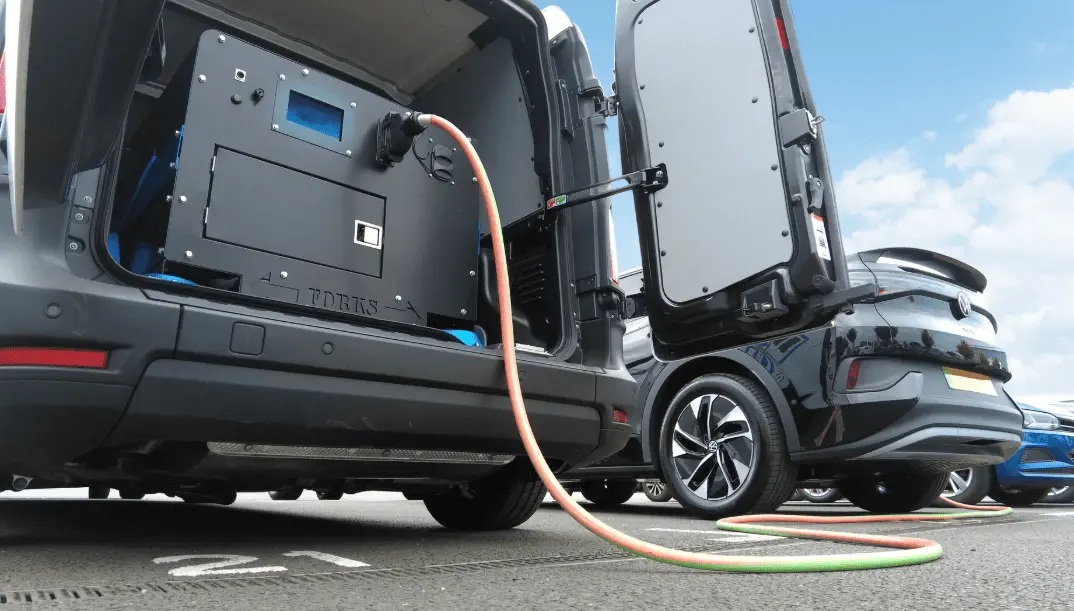Mobile EV Charging: Business Models, Market Potential, and Future Outlook
Introduction
The global transportation industry is undergoing a historic transformation, with electric vehicles (EVs) at the center of it. Once viewed as futuristic novelties, EVs have now gone mainstream, driven by declining battery costs, government incentives, and growing environmental awareness. As major automakers commit to phasing out internal combustion engine (ICE) vehicles, the shift to electrified mobility is no longer a question of if but when.
Yet this rapid transition raises a critical question: How do we keep EVs charged conveniently, reliably, and affordably? While fixed charging networks continue to expand, significant gaps remain—particularly in suburban regions, along highways, and in developing countries. This is where mobile EV charging services step in.
Mobile charging combines the flexibility of roadside assistance with the innovation of modern energy solutions. Whether it’s helping a stranded EV driver, topping up delivery fleets overnight, or powering vehicles at large events, mobile units bring electricity directly to the customer, bridging infrastructure gaps with speed and convenience.
For entrepreneurs and investors, mobile EV charging represents a unique opportunity: it solves a real-world challenge, aligns with global sustainability goals, and has the potential to scale rapidly alongside EV adoption. This article explores mobile charging business models, market insights, operational requirements, marketing strategies, and future prospects.
Business Models in Mobile EV Charging
1. On-Demand Mobile Charging
The most intuitive model mirrors roadside assistance. Customers request a charge when their battery runs low, and a mobile unit—equipped with battery packs or generators—arrives to deliver an emergency boost.
Use Cases:
- Stranded drivers on highways.
- Urban residents without home charging access.
- Tourists or business travelers in unfamiliar areas.
Market Insight:
- North America & Europe: Demand driven by high EV adoption and occasional infrastructure bottlenecks.
- Developing Regions: Essential where public charging is sparse, though EV volumes may limit scale.
2. Subscription-Based Charging-as-a-Service
This model offers predictable access through monthly plans that cover scheduled charging sessions or guaranteed emergency support.
Use Cases:
- Commuters without home chargers.
- Apartment dwellers with shared or limited parking.
- Corporate fleets requiring dependable charging.
Market Insight:
- Europe & North America: Attractive to professionals seeking cost predictability.
- Asia-Pacific: Suited for high-income urban drivers with limited infrastructure.
3. Event and Fleet Charging
Mobile services provide temporary or supplemental charging for large gatherings or corporate fleets.
Use Cases:
- Festivals, sports events, trade shows.
- Logistics firms running EV delivery vans.
- Rideshare fleets operating 24/7.
4. Hybrid Models
Many providers adopt a blended strategy, combining emergency services with fleet contracts and event coverage. Diversification reduces risk and builds multiple revenue streams.
Building a Mobile EV Charging Business Plan
A robust business plan is essential for securing funding and guiding growth. Key components include:
- Executive Summary: Define mission and value proposition (e.g., renewable-powered mobile units, rapid response).
- Market Analysis: Assess EV adoption trends, policies, and competition from fixed networks or startups.
- Services: Detail pricing structures (per kWh, flat-rate, subscription tiers).
- Marketing Strategy: Blend digital outreach with partnerships (dealerships, municipalities, fleets).
- Operations: Specify vehicles, chargers, dispatch platforms, and energy sourcing methods.
- Management Team: Highlight expertise in energy, logistics, or mobility.
- Financials: Project start-up costs, operating expenses, and break-even timelines.
Operations: Running a Mobile Charging Fleet
Fleet and Equipment
- Vans or trucks fitted with battery storage.
- DC fast chargers (20–80% in under an hour) or AC chargers for slower, predictable sessions.
- Power sourced from the grid, renewable hubs, or hybrid systems.
Technology and Dispatch
- Centralized platforms manage requests and fleet logistics.
- GPS routing optimizes response times.
- Mobile apps enable booking, live tracking, and digital payments.
Staffing and Training
- Technicians must be trained in EV safety, high-voltage systems, and customer service.
- Emergency protocols are critical for safety (e.g., battery overheating).
Service-Level Agreements (SLAs)
- Guarantee response times (e.g., 30 minutes).
- Ensure reliability through transparent commitments.
Marketing and Customer Acquisition
- Digital Marketing
- SEO optimization for EV-related searches (“EV charging near me”).
- Geo-targeted ads for stranded motorists.
- Educational content to raise awareness.
- Partnerships
- Collaborate with dealerships to offer free trials.
- Partner with municipalities for emergency coverage.
- Secure fleet contracts for recurring revenue.
- Retention and Branding
- Loyalty programs, referral bonuses, and premium packages.
- Eco-friendly branding to highlight sustainability.
Market Outlook
- North America: High adoption, long-distance driving needs.
- Europe: Strong regulatory push for zero-emission mobility.
- Asia-Pacific: China leads globally; India and Southeast Asia present emerging opportunities.
- Developing Regions: Sparse infrastructure makes mobile charging vital, though affordability remains a challenge.
Opportunities and Challenges
Opportunities
- Exploding EV adoption (200M+ EVs projected by 2030).
- Government subsidies and clean energy incentives.
- Fleet and event contracts provide reliable demand.
- Renewable integration enhances sustainability.
Challenges
- High upfront costs for vehicles, chargers, and software.
- Complex energy logistics for recharging mobile units.
- Regulatory hurdles vary by region.
- Competition from fixed networks and rival startups.
Case Studies
- SparkCharge (USA): On-demand charging via the “Currently” app.
- EV Safe Charge (USA): Specializes in event charging.
- ChargeUp (India): Portable solutions for dense urban environments.
These players demonstrate that business models must adapt to local conditions — what works in Los Angeles may not succeed in Mumbai.
Conclusion
Mobile EV charging is more than a stopgap — it is a critical enabler of mass EV adoption. By delivering flexibility, convenience, and peace of mind, mobile solutions directly address range anxiety while complementing fixed infrastructure.
For entrepreneurs, this is a chance to enter a fast-growing sector, solve a tangible pain point, and align with sustainability goals. Success depends on a clear business model, operational efficiency, customer-focused marketing, and adaptive partnerships.
As EV adoption accelerates worldwide, companies that scale mobile charging effectively will become indispensable players in tomorrow’s transportation ecosystem. It's important to know about Google SEO to help your website rank higher in search results.





Comments